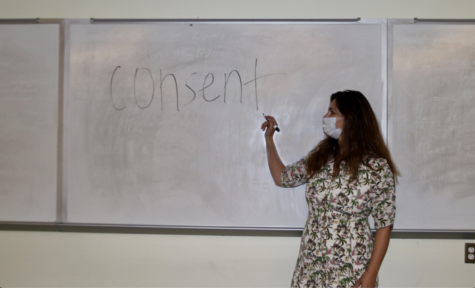OPINION | Lack of consent education perpetuates sexual violence
October 13, 2021

From a young age, children are conditioned to accept affection, whether or not they are comfortable. This translates into them lacking a perception of boundaries when it comes to theirs and others’ bodies. Not establishing the importance of consent early on can prove detrimental when children grow to be young adults that cannot grasp the concept of consent in a sexual situation.
While consent can seem like a too mature concept to discuss during childhood, conversations around consent do not necessarily have to be centered around its sexual connotation. Consent can range from teaching children how to accept “no” as an answer to simply asking before giving them a hug. Education on consent promotes respecting the decisions of others as well as making decisions about how and by whom one is touched.
Yet, most of the United States does not share the same sentimentality. In fact, only 24 states require sex education with less than half of those states mandating education on consent. Preventing sexual misconduct begins with transforming the way education tackles sex, bodily anatomy and relationships.
When accurate education on consent is not available or taught in schools, teens start to consume media that condone sexual violence and promote an unhealthy culture. It could be argued that this portrayal desensitizes people to the horrors of sexual assault.
A study found that exposure to one violent film a day for five days resulted in 52 men finding the violence of sexual assault less anxiety-inducing, less depressing and ultimately, less significant. The substitution of toxic media for education harms real people.
A climate survey conducted at Tulane University in 2017 depicted some disturbing information. Of all the students who completed the survey, both graduate and undergraduate students, “33% of women, 15% of men and 29% of genderqueer or gender non-conforming students reported having been sexually assaulted since they enrolled at Tulane.”
Perpetrators of sexual misconduct disacknowledge consent. Obviously consent education is not the ultimate solution for eradicating sexual violence, but it does aid in dismantling societal pressures.
These pressures come in the form of systems of oppression that work to give greater power to certain groups of people based on factors such as race, sexual orientation, gender and many other aspects of identity. For example, LGBTQ+ groups are disproportionately impacted by sexual violence.
In the same climate study, Tulane found that LGBTQ+ identifying students reported higher rates of sexual assault victimization than heterosexual and cisgender students did. Specifically, the highest rate of sexual assault victimization was report by LGBQ+ women at 51%, followed by 44% of GBQ+ men and 39% of heterosexual women.
An intersectional approach may be able to give confidence to those hesitant to reach out; students should feel safe when contacting available resources. Sadly, this hesitance arises from traumas numerous groups of people have faced and are still constantly facing.
It has been widely noted that sexual violence against women of color is a fundamental aspect of white supremacist and settler colonial societies. Additionally, while men are notably seen as the perpetrators and never victims, many male victims of sexual violence do not come forth due to the prevalence of toxic masculinity in America.
In the long run, it is critical that education systems and communities are able to recognize the complexity of reality; sexual violence prevention is multi-dimensional, and understanding various identities and specific needs can promote effective consent education.









Leave a Comment